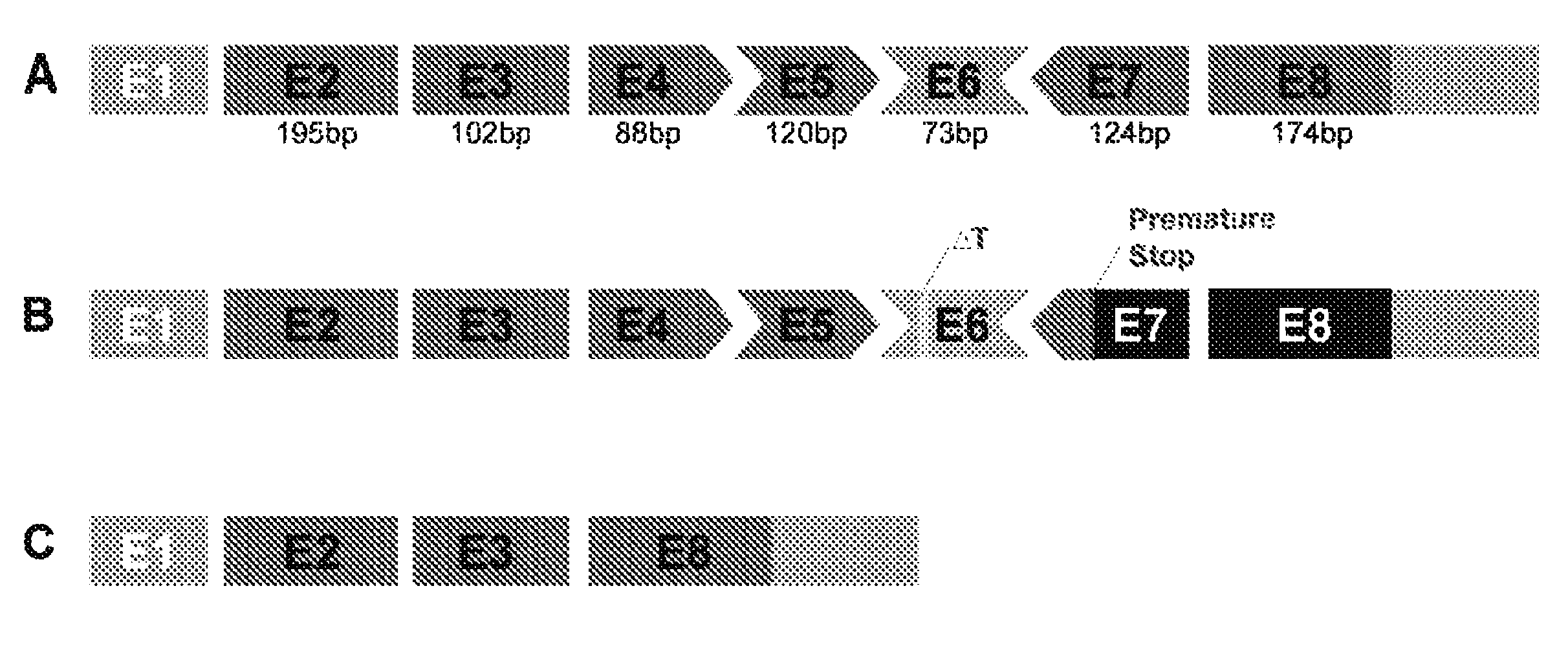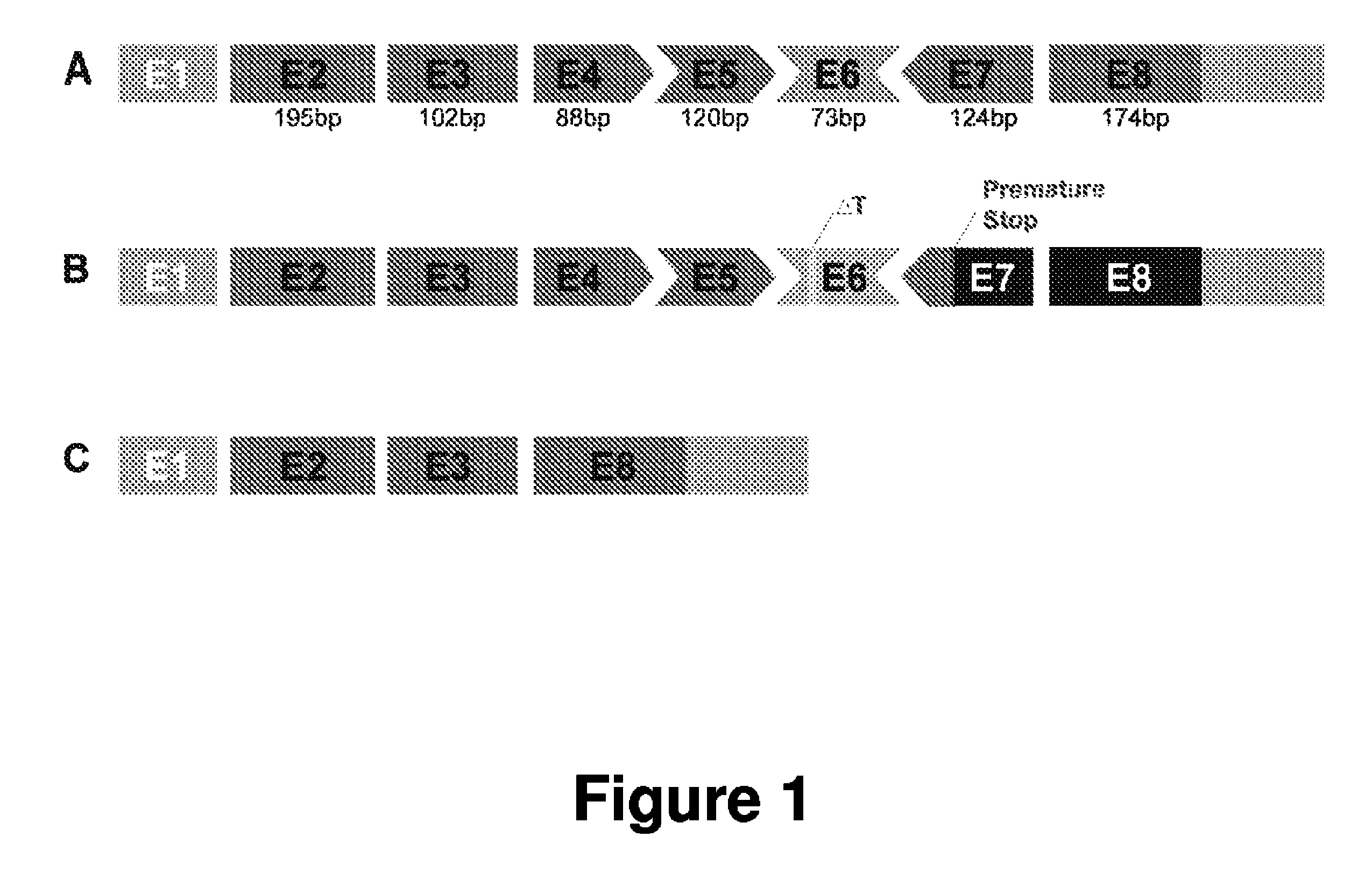Antisense polynucleotides to induce exon skipping and methods of treating dystrophies
a polynucleotide and exon skipping technology, applied in the field of antisense polynucleotides, can solve the problems of heart failure and breathing problems, more fragile and susceptible membrane tears of muscle membranes, necrotic cell death, etc., to inhibit the progression of dystrophic pathology, improve muscle function, and improve muscle function
- Summary
- Abstract
- Description
- Claims
- Application Information
AI Technical Summary
Benefits of technology
Problems solved by technology
Method used
Image
Examples
example 1
Rescue Efficiency of Mammalian Full Length γ-Sarcoglycan and Mini-Sgcg in Sarcoglycan Null Flies
[0140]The sarcoglycans are conserved between Drosophila and mammals. γ-sarcoglycan null flies develop symptoms similar to mammals. Transgenic flies expressing full-length murine γ-sarcoglycan and mini-Sgcg, were generated and it was found that mini-Sgcg protein correctly localizes at the plasma membrane of fly muscle cells.
[0141]γ / δ-sarcoglycan null flies (Sgcd840) were previously generated and characterized [Allikian et al., Hum Mol Genet 16: 2933-2943 (2007)]. Using PCR and Southern blot, it has been shown that exons 1 to 3 and partial exon 4 out of the 6 exons in the Drosophila Sgcd gene is deleted in Sgcd840 flies.
[0142]To determine whether mini-Sgcg retains the function of the full-length protein, the UAS-GAL4 system was utilized [Brand et al., Development. 118: 401-15 (1993)] to express two different sarcoglycan constructs. GAL4 is a transcription factor that recognizes a specific e...
example 2
Mini-Sgcg can Replace Full-Length Sgcg in the γ-Sarcoglycan Mutant Mouse Model
[0149]By characterizing the correction of mutant phenotype in an established mouse model, a more accurate prediction of the effect of replacing the full-length γ-sarcoglycan with the truncated γ-sarcoglycan in human patients can be determined.
Transgenic Mouse Expressing Mini-Sgcg in Muscle Using the Human Desmin Promoter with the Mini-Sgcg Coding Sequence
[0150]To test the function of mini-Sgcg in mice, transgenic mice expressing murine mini-Sgcg were generated using the desmin promoter which expresses in both heart and muscle cells [Pacak et al., Genet Vaccines Ther 6: 13 (2008)]. γ-sarcoglycan is required for proper function of both heart and skeletal muscle [Zhu et al., FASEB J 16: 1096-1098 (2002)]. To assess the rescue efficiency of γ-sarcoglycan sub-domains in both muscle tissues, the human desmin promoter is used. Desmin is an intermediate filament that is expressed in all muscle tissue, including he...
example 3
Exon Skipping in Muscle Culture Derived from Human Patients
[0166]The rationale for the experiments described below is that exon skipping requires optimization of antisense polynucleotides and proof-of-function in vitro.
Use MyoD Transformation to Induce Cultured Primary Human Fibroblasts to Become Myoblasts
[0167]Fibroblasts isolated from two LGMD2C patients carrying a deletion of exon 6 in the Sgcg gene have been obtained. MyoD is a master regulator of the muscle differentiation program. Forced expression of MyoD in fibroblasts can convert the fibroblasts to a muscle lineage [Lattanzi et al., J Clin Invest 101: 2119-2128 (1998)].
[0168]MyoD is a key initiator of the skeletal muscle differentiation program [Weintraub et al., Science 251: 761-766 (1991)]. MyoD is responsible for activating other essential muscle regulators, such as myocyte enhancer factor-2 (MEF2) and myogenin. It has been shown that forced expression of MyoD in fibroblasts is able to convert fibroblasts to myoblasts bo...
PUM
| Property | Measurement | Unit |
|---|---|---|
| Tm | aaaaa | aaaaa |
| length | aaaaa | aaaaa |
| muscle strength | aaaaa | aaaaa |
Abstract
Description
Claims
Application Information
 Login to View More
Login to View More - R&D
- Intellectual Property
- Life Sciences
- Materials
- Tech Scout
- Unparalleled Data Quality
- Higher Quality Content
- 60% Fewer Hallucinations
Browse by: Latest US Patents, China's latest patents, Technical Efficacy Thesaurus, Application Domain, Technology Topic, Popular Technical Reports.
© 2025 PatSnap. All rights reserved.Legal|Privacy policy|Modern Slavery Act Transparency Statement|Sitemap|About US| Contact US: help@patsnap.com



